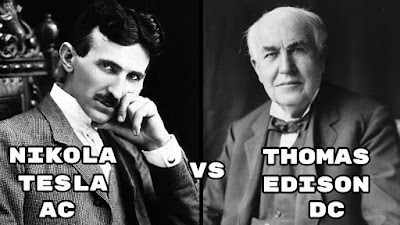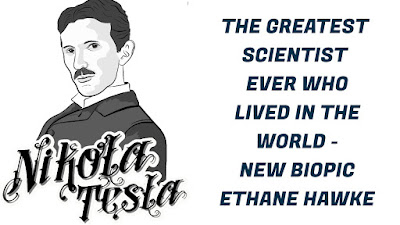Nikola Tesla vs Thomas Edison - AC vs DC - Who Was The Best ? - War For The Currents
Today Tesla is a geek icon, credited with pioneering alternating current and radio. He inspires tributes around the world (and occasionally long gardening sessions). That geeky cult is part of the reason the new Tesla Center is being built. Matthew Inman, author of a famous comic strip at the Oatmeal about how Tesla is awesome, kicked off a $1.37 million crowdfunding campaign to help build the new museum.
But that enthusiasm has come at a cost — slamming Thomas Edison at every opportunity. In the popular imagination, Tesla and Edison were mortal enemies, and everybody has to pick a side. Inman's famous comic argues that Tesla, not Edison, was "the greatest geek who ever lived," while Edison "was a [censored] idiot" who stole ideas and merely profited off patents.
But the Tesla-Edison rivalry reaches far beyond a webcomic that's a few years old. It's gone from viral image to ever-present meme to pop culture canon. Rather than fizzling in the past couple of years, the feud's hype has only grown. It's shown up on T-shirts, in movie speculation, and even in parody rap battles.
That the rivalry has boomed is all new and a bit surreal. For most of the 20th century, Edison was America's greatest inventor and a hero of the industrial age, valorized for his hard work and ingenuity. But lately, it's Tesla who's seen his stature rise as a hero of the big idea and the true symbol of Silicon Valley–style innovation. The two are portrayed as representing completely different ideas of scientific progress, with a rivalry fit for a summer movie.
But is that blockbuster battle really accurate? A closer look at the historical feud between Tesla and Edison suggests that how we think of them today says less about the two inventors than it does about ourselves.
But is that blockbuster battle really accurate? A closer look at the historical feud between Tesla and Edison suggests that how we think of them today says less about the two inventors than it does about ourselves.
NIKOLA TESLA DOCUMENTARY
THOMAS ALVA EDISON DOCUMENTARY
A year later, Tesla left to start his own electric lighting company. The new system he used relied on alternating currents for induction motors — which set the stage for his famous conflict with Edison.
The dispute centered on which type of electric current should become the universal standard in the United States. Edison preferred direct current (DC), which was already widely used (and which Edison was profiting off of through his patents). But DC had a key drawback: It was difficult to convert the low voltage from power plants into high-voltage transmission lines that could carry electricity long distances. So a DC system would require many smaller power plants built close to users.
Tesla's alternating current (AC) system fixed this problem. Using transformers, the voltages could be raised and lowered, making it possible to have power plants many miles from wherever power was being used. Tesla sold his patents to George Westinghouse, who promoted the new AC system against Edison's.
The resulting "current wars" did turn into a genuine rivalry — at least for a while. Edison launched a publicity campaign to promote DC, which included public displays of AC electrocution in front of a live audience. In 1903, Edison supervised workers as they electrocuted an elephant named Topsy. (The logic wasn't particularly sound: It was like saying drowning cats in vats of soda proves that sugar is bad for you.
TESLA VS EDISON EARLY DAYS
In 1884, a 28-year-old Serbian named Nikola Tesla arrived in New York City and quickly found a job with Thomas Edison, who, at 37, had already invented a new type of telegraph, created a pioneering lab, and founded the Edison Illuminating Company that developed Edison's work in electrical light. In his new position, Tesla helped Edison install lab equipment, repair generators, and design new machines.
A year later, Tesla left to start his own electric lighting company. The new system he used relied on alternating currents for induction motors — which set the stage for his famous conflict with Edison.
The dispute centered on which type of electric current should become the universal standard in the United States. Edison preferred direct current (DC), which was already widely used (and which Edison was profiting off of through his patents). But DC had a key drawback: It was difficult to convert the low voltage from power plants into high-voltage transmission lines that could carry electricity long distances. So a DC system would require many smaller power plants built close to users.
Tesla's alternating current (AC) system fixed this problem. Using transformers, the voltages could be raised and lowered, making it possible to have power plants many miles from wherever power was being used. Tesla sold his patents to George Westinghouse, who promoted the new AC system against Edison's.
The resulting "current wars" did turn into a genuine rivalry — at least for a while. Edison launched a publicity campaign to promote DC, which included public displays of AC electrocution in front of a live audience. In 1903, Edison supervised workers as they electrocuted an elephant named Topsy. (The logic wasn't particularly sound: It was like saying drowning cats in vats of soda proves that sugar is bad for you.
But the spat also ended pretty quickly — and Edison lost. As early as 1893, Westinghouse had won a bid to electrify the World's Fair. By 1896, General Electric had ditched DC for AC, which eventually became the dominant system in the United States. And Tesla, for his part, moved on to new inventions quickly —by 1892, he was already lecturing in London about his plans forradio. Edison's elephant electrocution was an after-the-fact flail at relevance — DC had already lost.
Historians say this feud was a blip, not an epic conflict. And it just wasn't as bitter as today's mythmakers suggest. "Tesla just didn't worry about Edison," says W. Bernard Carlson, who wrote about Tesla in Tesla: Inventor of the Electrical Age. "He actually kind of idolized him when he worked for him. He was annoyed, but there wasn't this lifelong bitter animosity that you see being conjured up." (If Tesla fans are looking for a true rival, every biographer I talked to suggested Guglielmo Marconi, who built off Tesla's work to "invent" radio. Their rivalry actually had the vitriol we imagine in the Tesla-Edison dispute.)
The "current wars" were a fascinating but short-lived business dispute. The tougher question is how this spat got transformed, in our historical memory, into a battle more fit for a Marvel movie than a business textbook.




Comments
Post a Comment